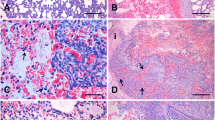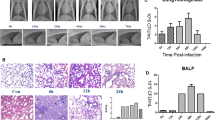Abstract
Actinobacillus pleuropneumoniae is an important porcine respiratory pathogen causing great economic losses in the pig industry worldwide. Oxygen deprivation is a stress that A. pleuropneumoniae will encounter during both early infection and the later, persistent stage. To understand modulation of A. pleuropneumoniae gene expression in response to the stress caused by anaerobic conditions, gene expression profiles under anaerobic and aerobic conditions were compared in this study. The microarray results showed that 631 genes (27.7% of the total ORFs) were differentially expressed in anaerobic conditions. Many genes encoding proteins involved in glycolysis, carbon source uptake systems, pyruvate metabolism, fermentation and the electron respiration transport chain were up-regulated. These changes led to an increased amount of pyruvate, lactate, ethanol and acetate in the bacterial cells as confirmed by metabolite detection. Genes encoding proteins involved in cell surface structures, especially biofilm formation, peptidoglycan biosynthesis and lipopolysaccharide biosynthesis were up-regulated as well. Biofilm formation was significantly enhanced under anaerobic conditions. These results indicate that induction of central metabolism is important for basic survival of A. pleuropneumoniae after a shift to an anaerobic environment. Enhanced biofilm formation may contribute to the persistence of this pathogen in the damaged anaerobic host tissue and also in the early colonization stage. These discoveries give new insights into adaptation mechanisms of A. pleuropneumoniae in response to environmental stress.
Similar content being viewed by others
Refrerences
Auger E., Deslandes V., Ramjeet M., Contreras I., Nash J.H., Harel J., Gottschalk M., Olivier M., and Jacques M. 2009. Hostpathogen interactions of Actinobacillus pleuropneumoniae with porcine lung and tracheal epithelial cells. Infect. Immun. 77, 1426–1441.
Baltes N., Hennig-Pauka I., Jacobsen I., Gruber A.D., and Gerlach G.F. 2003. Identification of dimethyl sulfoxide reductase in Actinobacillus pleuropneumoniae and its role in infection. Infect. Immun. 71, 6784–6792.
Baltes N., N’Diaye M., Jacobsen I.D., Maas A., Buettner F.F., and Gerlach G.F. 2005. Deletion of the anaerobic regulator HlyX causes reduced colonization and persistence of Actinobacillus pleuropneumoniae in the porcine respiratory tract. Infect. Immun. 73, 4614–4619.
Bosse J.T., Janson H., Sheehan B.J., Beddek A.J., Rycroft A.N., Kroll J.S., and Langford P.R. 2002. Actinobacillus pleuropneumoniae: pathobiology and pathogenesis of infection. Microbes Infect. 4, 225–235.
Bosse J.T., Sinha S., Li M.S., O’Dwyer C.A., Nash J.H., Rycroft A.N., Kroll J.S., and Langford P.R. 2010. Regulation of pga operon expression and biofilm formation in Actinobacillus pleuropneumoniae by sigmaE and H-NS. J. Bacteriol. 192, 2414–2423.
Buettner F.F., Bendallah I.M., Bosse J.T., Dreckmann K., Nash J.H., Langford P.R., and Gerlach G.F. 2008a. Analysis of the Actinobacillus pleuropneumoniae ArcA regulon identifies fumarate reductase as a determinant of virulence. Infect. Immun. 76, 2284–2295.
Buettner F.F., Maas A., and Gerlach G.F. 2008b. An Actinobacillus pleuropneumoniae arcA deletion mutant is attenuated and deficient in biofilm formation. Vet. Microbiol. 127, 106–115.
Buettner F.F., Bendalla I.M., Bosse J.T., Meens J., Nash J.H., Hartig E., Langford P.R., and Gerlach G.F. 2009. Analysis of the Actinobacillus pleuropneumoniae HlyX (FNR) regulon and identification of iron-regulated protein B as an essential virulence factor. Proteomics 9, 2383–2398.
Chiers K., De Waele T., Pasmans F., Ducatelle R., and Haesebrouck F. 2010. Virulence factors of Actinobacillus pleuropneumoniae involved in colonization, persistence and induction of lesions in its porcine host. Vet. Res. 41, 65.
Deslandes V., Denicourt M., Girard C., Harel J., Nash J.H., and Jacques M. 2010. Transcriptional profiling of Actinobacillus pleuropneumoniae during the acute phase of a natural infection in pigs. BMC Genomics 11, 98.
Deslandes V., Nash J.H., Harel J., Coulton J.W., and Jacques M. 2007. Transcriptional profiling of Actinobacillus pleuropneumoniae under iron-restricted conditions. BMC Genomics 8, 72.
Fuchs S., Pane-Farre J., Kohler C., Hecker M., and Engelmann S. 2007. Anaerobic gene expression in Staphylococcus aureus. J. Bacteriol. 189, 4275–4289.
Fux C.A., Costerton J.W., Stewart P.S., and Stoodley P. 2005. Survival strategies of infectious biofilms. Trends Microbiol. 13, 34–40.
Gorke B. and Stulke J. 2008. Carbon catabolite repression in bacteria: many ways to make the most out of nutrients. Nat. Rev. Microbiol. 6, 613–624.
Hall-Stoodley L., Costerton J.W., and Stoodley P. 2004. Bacterial biofilms: from the natural environment to infectious diseases. Nat. Rev. Microbiol. 2, 95–108.
Izano E.A., Sadovskaya I., Vinogradov E., Mulks M.H., Velliyagounder K., Ragunath C., Kher W.B., Ramasubbu N., Jabbouri S., Perry M.B., and et al. 2007. Poly-N-acetylglucosamine mediates biofilm formation and antibiotic resistance in Actinobacillus pleuropneumoniae. Microb. Pathog. 43, 1–9.
Jacobsen I., Hennig-Pauka I., Baltes N., Trost M., and Gerlach G.F. 2005. Enzymes involved in anaerobic respiration appear to play a role in Actinobacillus pleuropneumoniae virulence. Infect. Immun. 73, 226–234.
Kaplan J.B. and Mulks M.H. 2005. Biofilm formation is prevalent among field isolates of Actinobacillus pleuropneumoniae. Vet. Microbiol. 108, 89–94.
Kaplan J.B., Velliyagounder K., Ragunath C., Rohde H., Mack D., Knobloch J.K., and Ramasubbu N. 2004. Genes involved in the synthesis and degradation of matrix polysaccharide in Actinobacillus actinomycetemcomitans and Actinobacillus pleuropneumoniae biofilms. J. Bacteriol. 186, 8213–8220.
Klitgaard K., Friis C., Jensen T.K., Angen O., and Boye M. 2012. Transcriptional portrait of Actinobacillus pleuropneumoniae during acute disease-potential strategies for survival and persistence in the host. PLoS One 7, e35549.
Labrie J., Pelletier-Jacques G., Deslandes V., Ramjeet M., Auger E., Nash J.H., and Jacques M. 2010. Effects of growth conditions on biofilm formation by Actinobacillus pleuropneumoniae. Vet. Res. 41, 3.
Li L., Xu Z., Zhou Y., Li T., Sun L., Chen H., and Zhou R. 2011. Analysis on Actinobacillus pleuropneumoniae LuxS regulated genes reveals pleiotropic roles of LuxS/AI-2 on biofilm formation, adhesion ability and iron metabolism. Microb. Pathog. 50, 293–302.
Li L., Xu Z., Zhou Y., Sun L., Liu Z., Chen H., and Zhou R. 2012. Global effects of catecholamines on Actinobacillus pleuropneumoniae gene expression. PLoS One 7, e31121.
Li L., Zhou R., Li T., Kang M., Wan Y., Xu Z., and Chen H. 2008. Enhanced biofilm formation and reduced virulence of Actinobacillus pleuropneumoniae luxS mutant. Microb. Pathog. 45, 192–200.
Lone A.G., Deslandes V., Nash J.H., Jacques M., and MacInnes J.I. 2009a. malT knockout mutation invokes a stringent type gene-expression profile in Actinobacillus pleuropneumoniae in bronchoalveolar fluid. BMC Microbiol. 9, 1–5.
Lone A.G., Deslandes V., Nash J.H., Jacques M., and Macinnes J.I. 2009b. Modulation of gene expression in Actinobacillus pleuropneumoniae exposed to bronchoalveolar fluid. PLoS One 4, e6139.
Magnusson L.U., Farewell A., and Nystrom T. 2005. ppGpp: a global regulator in Escherichia coli. Trends Microbiol. 13, 236–242.
Negrete-Abascal E., Tenorio V.R., Guerrero A.L., Garcia R.M., Reyes M.E., and de la Garza M. 1998. Purification and characterization of a protease from Actinobacillus pleuropneumoniae serotype 1, an antigen common to all the serotypes. Can. J. Vet. Res. 62, 183–190.
Negrete-Abascal E., Tenorio V.R., Serrano J.J., Garcia C., and de la Garza M. 1994. Secreted proteases from Actinobacillus pleuropneumoniae serotype 1 degrade porcine gelatin, hemoglobin and immunoglobulin A. Can. J. Vet. Res. 58, 83–86.
Paul B.J., Barker M.M., Ross W., Schneider D.A., Webb C., Foster J.W., and Gourse R.L. 2004. DksA: a critical component of the transcription initiation machinery that potentiates the regulation of rRNA promoters by ppGpp and the initiating NTP. Cell 118, 311–322.
Persson O., Valadi A., Nystrom T., and Farewell A. 2007. Metabolic control of the Escherichia coli universal stress protein response through fructose-6-phosphate. Mol. Microbiol. 65, 968–978.
Rycroft A.N. and Garside L.H. 2000. Actinobacillus species and their role in animal disease. Vet. J. 159, 18–36.
Salmon K.A., Hung S.P., Steffen N.R., Krupp R., Baldi P., Hatfield G.W., and Gunsalus R.P. 2005. Global gene expression profiling in Escherichia coli K12: effects of oxygen availability and ArcA. J. Biol. Chem. 280, 15084–15096.
Wong S.M., Alugupalli K.R., Ram S., and Akerley B.J. 2007. The ArcA regulon and oxidative stress resistance in Haemophilus influenzae. Mol. Microbiol. 64, 1375–1390.
Xu Z., Zhou Y., Li L., Zhou R., Xiao S., Wan Y., Zhang S., Wang K., Li W., Jin H., and et al. 2008. Genome biology of Actinobacillus pleuropneumoniae JL03, an isolate of serotype 3 prevalent in China. PLoS One 3, e1450.
Author information
Authors and Affiliations
Corresponding author
Additional information
Supplemental material for this article may be found at http://www.springerlink.com/content/120956.
Electronic supplementary material
Rights and permissions
About this article
Cite this article
Li, L., Zhu, J., Yang, K. et al. Changes in gene expression of Actinobacillus pleuropneumoniae in response to anaerobic stress reveal induction of central metabolism and biofilm formation. J Microbiol. 52, 473–481 (2014). https://doi.org/10.1007/s12275-014-3456-y
Received:
Revised:
Accepted:
Published:
Issue Date:
DOI: https://doi.org/10.1007/s12275-014-3456-y




